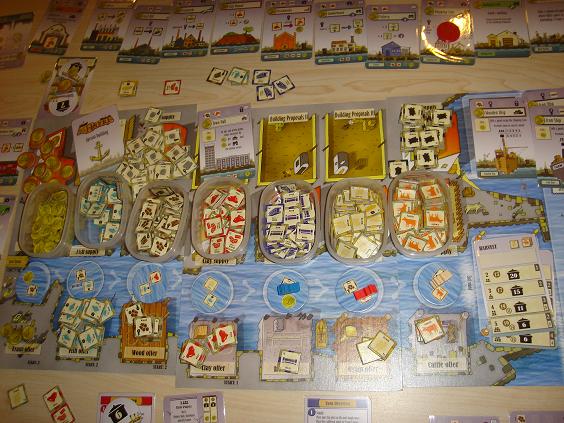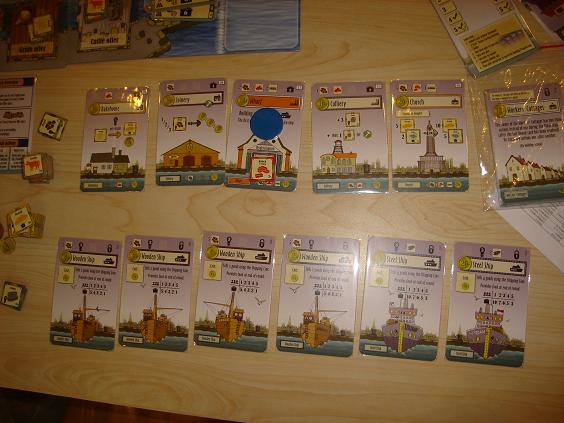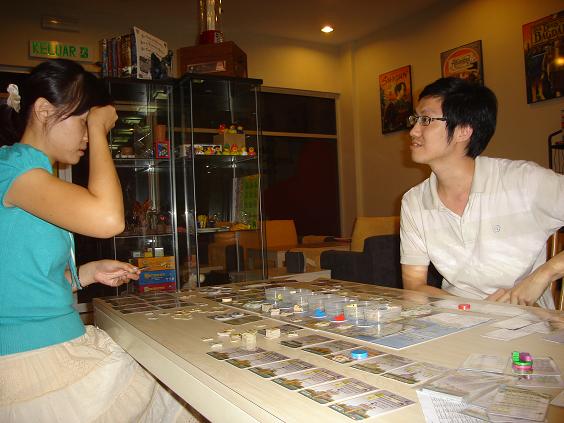
We actually first played Le Havre quite some time ago when Sean first got his copy. Since both of us like Agricola quite a bit, we were both eager to try it when it arrived but found it to be quite a bit more complex and were left somewhat confused. Our initial impressions were still favorable as there seemed to be a lot to learn and experiment with but for various reasons, we weren’t able to play it for a second time until recently.
Le Havre shares many superficial similarities with Agricola. For example, buildings act much like action spaces in the latter and you can place a worker in one to execute the associated action immediately. At the end of every round, each player also needs to pay increasing amounts of food as a form of upkeep. And since its also an economic game, it comes with a bewildering variety of chits to represent resources and the main board serves mainly just to record which resources and cards are currently available and whose turn it is.
When it comes to playing it however, Le Havre feels very different but it’s very hard to explain why exactly this is so. One reason is that for all the options provided by the Minor Improvement and Occupation cards in Agricola, the highly structured scoring system means that all players must eventually do a little bit of everything. A well-rounded farm in the older game beats an extremely specialized one every time. By contrast, the scoring system in Le Havre is completely open. What matters at the end of the game is how wealthy you are, irrespective of what form your wealth takes and how you came by it.

Add to the fact that the penalties for missing the food upkeep costs in this game are very forgiving compared to Agricola where taking even a single Begging Card usually spells defeat, and you realize that the options in Le Havre are so open that as a newcomer you’re at a loss at what to do. Since you’re not forced down any particular path, it can be very intimidating to look at all of the many ways you can create value in this game and decide on a course of action. For example, constructing buildings create value because the value of a building is more than the value of the resources than goes into it, but you can also use buildings to process the standard goods into upgraded versions and sell them with your fleet of ships. The problem is that it can be very hard to tell which path creates more value because you also need to factor in how many actions it’ll take to accomplish something.
Normally this tends to lead to analysis paralysis but there are so many different goods and possible paths to take in Le Havre that I think players get dissuaded from analyzing too much and just go with their instincts and experience. Even so, while the scoring system is open it appears that there are preferred paths through the game. Leather goods for example don’t seem very worthwhile unless the right Special Buildings are out while essentials like coke and iron are always fiercely fought over. Blocking isn’t as critical in Le Havre as in Agricola but it does happen and this is when you use your available action to develop other opportunities.
Anyway I really can’t decide yet what to make of this game. I think I’ll have to buy it eventually to give myself enough time to tinker around with it. On the one hand, it does seem interesting to play around with all the options to make money to see what sequences of actions earns the most, but at the same time I can’t help but think that every game ends up feeling more or less the same. In Agricola, even the same actions feel very different depending on when you execute them, but timing doesn’t seem to matter as much in Le Havre. The special buildings look like they’re supposed to mix things up every game but they don’t seem to make as dramatic a difference as the cards in Agricola. I get the impression that regardless of what cool ideas you have this time around, you always end up making more or less the same decisions in every session of Le Havre.

Finally, for all the care and balancing decisions that Uwe Rosenberg obviously put into the game, I can’t shake the feeling that the game seems clunky and inelegant. Food requirements and food provided by ships change depending on the number of players in the game. Agricola not only feels much more streamlined but its mechanics are a better fit for its theme as well. You intuitively understand that placing a worker on the Wood space means sending someone out to chop wood for example, but in Le Havre it’s odd how claiming a batch of goods not only doesn’t involve putting a worker there but that worker still occupies the building he was previously in even though he might not have been doing anything there for a long time now. I can understand the gameplay decisions for such rules but they still seem jarring and intuitively wrong to me theme-wise.
2 Responses to “Le Havre”
That photo of 6 ships made me chuckle. You are building an armada to invade England? 😀
I like Le Havre almost as much as Agricola. I think the random special cards can make a big difference to the game, but it depends on whether there are players making use of them, and also whether the timing of their appearance suits the needs of the players. I must admit I myself often don’t pay much attention to them.
That was from the first session months ago. I really don’t recall what I was thinking then. I only recently realized that ships aren’t really good value in of themselves because of their low value to resources needed to construct them ratio, so you shouldn’t really build more than you need for food and shipping.
Leave a Reply